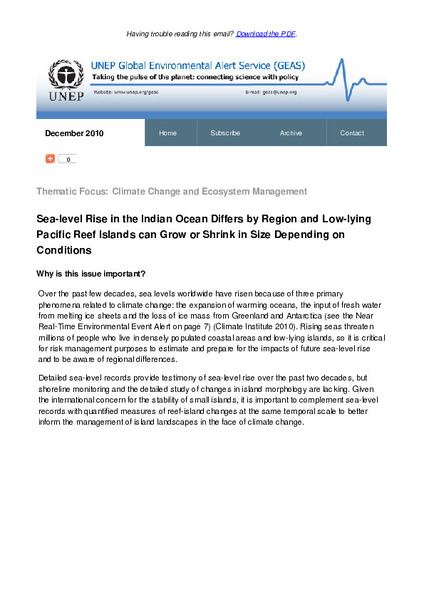| dc.contributor | Science Division | en_US |
| dc.contributor.author | United Nations Environment Programme | en_US |
| dc.coverage.spatial | Asia and the Pacific | en_US |
| dc.date.accessioned | 2022-10-17T11:35:54Z | |
| dc.date.available | 2022-10-17T11:35:54Z | |
| dc.date.issued | 2010-12 | |
| dc.identifier.uri | https://wedocs.unep.org/20.500.11822/40851 | |
| dc.description | Over the past few decades, sea levels worldwide have risen because of three primary phenomena related to climate change: the expansion of warming oceans, the input of fresh water from melting ice sheets and the loss of ice mass from Greenland and Antarctica (see the Near Real-Time Environmental Event Alert on page 7) (Climate Institute 2010). Rising seas threaten millions of people who live in densely populated coastal areas and low-lying islands, so it is critical for risk management purposes to estimate and prepare for the impacts of future sea-level rise and to be aware of regional differences. | en_US |
| dc.format | Text | en_US |
| dc.language | English | en_US |
| dc.relation.ispartof | UNEP Global Environmental Alert Service (GEAS) | en_US |
| dc.rights | Public | en_US |
| dc.subject | climate change | en_US |
| dc.subject | Indian Ocean | en_US |
| dc.subject | rising sea level | en_US |
| dc.subject | sea level rise | en_US |
| dc.subject | Asia and the Pacific | en_US |
| dc.title | Sea-level Rise in the Indian Ocean Differs by Region and Low-lying Pacific Reef Islands can Grow or Shrink in Size Depending on Conditions - UNEP Global Environmental Alert Service (GEAS) December 2010 | en_US |


